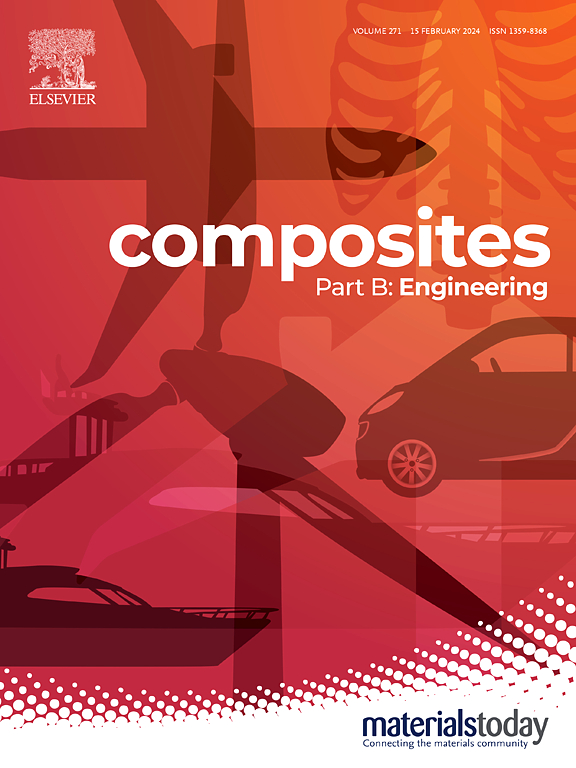Characterization of low-velocity impact response and damage tolerance of thermoplastic/thermoset composite laminates under strong and complex preload
IF 12.7
1区 材料科学
Q1 ENGINEERING, MULTIDISCIPLINARY
引用次数: 0
Abstract
In this study, a novel uni/biaxial preload-coupling loading device is designed to systematically investigate the low-velocity impact mechanical response and the evolution of Compression After Impact (CAI) strength of thermoplastic/thermoset (TP/TS) laminates under seven typical loading boundary conditions. The influence of preload forms and clamping boundary conditions on the impact mechanical response and damage evolution of TP/TS laminates is first comparatively analyzed. The regulation mechanism of preload forms on the compressive failure behavior of laminates is elucidated through the innovative integration of three-dimensional digital image correlation (3D-DIC) and infrared thermography monitoring techniques. Through multiple regression analysis, a quantitative correlation model is established between damage characteristic parameters (such as dent depth, delamination damage projection area (DDPA), and energy dissipation) and CAI strength. Experimental results indicate that preload types and loading boundary conditions significantly affect the damage tolerance performance of laminates. Specifically, TS laminates under uniaxial compressive preload exhibit a typical “catastrophic” delamination failure mode, while TP laminates demonstrate superior damage tolerance characteristics. Furthermore, the dual-parameter evaluation model based on dent depth and DDPA overcomes the limitations of traditional single damage parameter assessments, providing a significant methodological reference for load-compatibility design and safety evaluation of composite structures in aerospace applications.

热塑性/热固性复合材料层合板在强、复杂预载荷下的低速冲击响应和损伤容限特性
本文设计了一种新型的单/双轴预载荷耦合加载装置,系统研究了热塑性/热固性(TP/TS)层压板在7种典型加载边界条件下的低速冲击力学响应和冲击后压缩(CAI)强度的演变。首先比较分析了预紧形式和夹紧边界条件对TP/TS层合板冲击力学响应和损伤演化的影响。通过三维数字图像相关(3D-DIC)和红外热成像监测技术的创新集成,阐明了预紧形式对层压板压缩破坏行为的调节机制。通过多元回归分析,建立了凹痕深度、分层损伤投影面积(DDPA)、能量耗散等损伤特征参数与CAI强度的定量关联模型。实验结果表明,预加载类型和加载边界条件对层合板的损伤容限性能有显著影响。具体而言,TS层合板在单轴压缩预载荷作用下表现出典型的“灾难性”分层破坏模式,而TP层合板表现出优越的损伤容限特性。此外,基于凹痕深度和DDPA的双参数评估模型克服了传统单一损伤参数评估的局限性,为航空航天复合材料结构的载荷兼容设计和安全性评估提供了重要的方法参考。
本文章由计算机程序翻译,如有差异,请以英文原文为准。
求助全文
约1分钟内获得全文
求助全文
来源期刊

Composites Part B: Engineering
工程技术-材料科学:复合
CiteScore
24.40
自引率
11.50%
发文量
784
审稿时长
21 days
期刊介绍:
Composites Part B: Engineering is a journal that publishes impactful research of high quality on composite materials. This research is supported by fundamental mechanics and materials science and engineering approaches. The targeted research can cover a wide range of length scales, ranging from nano to micro and meso, and even to the full product and structure level. The journal specifically focuses on engineering applications that involve high performance composites. These applications can range from low volume and high cost to high volume and low cost composite development.
The main goal of the journal is to provide a platform for the prompt publication of original and high quality research. The emphasis is on design, development, modeling, validation, and manufacturing of engineering details and concepts. The journal welcomes both basic research papers and proposals for review articles. Authors are encouraged to address challenges across various application areas. These areas include, but are not limited to, aerospace, automotive, and other surface transportation. The journal also covers energy-related applications, with a focus on renewable energy. Other application areas include infrastructure, off-shore and maritime projects, health care technology, and recreational products.
 求助内容:
求助内容: 应助结果提醒方式:
应助结果提醒方式:


